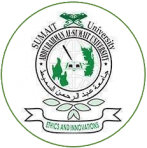UMUHIMU WA UWIANO KATI YA MALENGO MAHUSUSI NA MAZOEZI YA STADI YA KUZUNGUMZA KWA WANAOJIFUNZA KISWAHILI KAMA LUGHA YA KIGENI
Keywords:
Correlation, specific objectivesand speaking exercisesAbstract
SUMAIT University Journal (SUJ)ISSN (2507-7864) Issue No.11 (December, 2022)Kahindis468@gmail.comhttps://www.journal.sumait.ac.tzUmuhimu wa Uwiano kati ya Malengo mahususi na Mazoezi ya Stadi ya Kuzungumza kwa Wanaojifunza Kiswahili kama Lugha ya KigeniSalama Said KahindiThe State University of Zanzibar (SUZA), Zanzibar, Tanzania.Kahindis468@gmail.com _______________________________________________________________________________________________Received: 1April2022,Accepted: 23June2022, Published: December 2022© SUMAIT University Journal 2022Abstract:When teaching a foreign language, it is important that tasks to improve speaking skills correlate with specific objectives. Various scholars have discussed the concept of correlation in studies about teaching and learning foreign languages. These studies generally confirm that correlation ensures students have an expectation of what is being taught (Kurt, 2020). This study examined the correlation between specific objectives and speaking exercises in a class of learners who are learning Kiswahili as a foreign language. This article explains and emphasizes the importance of correlation in this setting, as the experience showed how some teachers who teach Kiswahili as a foreign language fail to set specific objectives for speaking skill exercises. This articlewill also show ways of finding out if specific objectives have been achieved, how to correlate specific objectives and exercises, and will demonstrate the importance of correlation between specific objectives and speaking skill exercises. Data for this study was collected through semi structured interviews and documentary analysis. Data was analyzed using a descriptive approach. Research findings have confirmed that teachers were somewhat familiar with the concept of correlation. Therefore, it is recommended that the foreign language teaching center focus on training on correlation in teaching, especially the correlation between specific objectives and exercises that assess students
Downloads
References
-Ali, L. H. (2015). Changamoto na mbinu za kiisimu katika ufundishaji wa stadi ya mazungumzo kwa wanafunzi wa elimu ya awali. (Tasnifu ya Uzamili). Chuo Kikuu Huria cha Tanzania-Anuradha, R. V., Roman, G. & Hemamalini, H.C. (2014). Methods of teaching English. Neelkamal Publication.-BAKIZA. (2010). Kamusi la Kiswahili fasaha. Oxford University Press.-Bandara, D. & Wijekularathna, D.K. (2017). Comparison ofstudent performance under two teaching methods: Face to face and online. The International Journal of Educational Research, vol 12 (1), pg 69-79.-Brandl, K. (2007). Communicative language teaching in action: Putting principles to work. Upper saddle river.-Burk, J. J. (2016). Language learning for real-worldcontext. (Master’s research) Utah state University-Chen, L. (1997). Distance delivery systems in terms of pedagogical considerations: A revolution. Educational Technology, vol 37 (4), pg 34-37.-Chuo Kikuu cha Taifa cha Zanzibar. (2013). Zungumza Kiswahili: Hatua ya kwanza. Educational Books Publishers Ltd.-Corder, S. (1987). Error analysis and interlanguages. Oxford University Press.-Disha, M. (n/d). Evaluation in teaching and learning Process.-Ephraim, E. (2016). Upimaji natathmini. https://www.sribd.com/ documen t /3299 12066/ upimaji-tathmini-pdf-Garbade, M. J. (2018). Four tricks to know if eLearning objectives are met.-Hattie, J. (2011). Feedback in schools. In R. Sutton., M. J. Hornsey. & K. M. Douglas (Eds.), Feedback: The communication of praise, criticism and advice. Peter Lang Publishing. -Hussain, S. (2017). Teaching speaking skills in communication classroom. International Journal of Media, Journalism and Mass Communication, vol 3, issue 3, pg 14-21.-Julien, G. &Dookwah, R. (2020). Student’s transition from face to face learning to online learning athigher education: A case study in Trinidad and Tobago. AcademicJournals, vol 15 (8), pg 487-494.-Jyotsna, M. & Rao, S. N. (2009). Methods of teaching English. New Era Publication-Kawasaki, J. (2021). What is task based learning? A guide to the popular teaching method. https://bridge.edu/tefl/blog/what-is-task-based-learning/#-Klippel, F. (1984). Keep talking: communicative fluency activities forlanguage teaching. Cambridge University Press.-Kurt,S. (2020). How can we align learning objectives, instructional strategies and assessment?
Umuhimu wa Uwiano kati ya Malengo mahususi na Mazoezi ya Stadi ya Kuzungumza kwa Wanaojifunza Kiswahili kama Lugha ya Kigeni, Salama Said https://www.journal.sumait.ac.tz-Makame, K. O. (2019). Mkabala wa kimawasiliano katika ufundishaji wa lugha ya pili: Mifano kutoka ufundishaji waKiswahili kwa wageni Tanzania.African Journals Online, vol 82 No. 1 (2019).-Mayor, M. (2016). SMART objectives for smart teachers. Pearson-Miles, D., Mesinga, J. &Zuchowski. (2018). Harnessing opportunities to enhance the distance learning experience ofMSW students: An Appreciative Inquiry Process. Social Work Education,37 (6), pg 705-717. https://doi.org/10.1080/02615479.2018.1447557-Pearson. (2016). Providingeducationalfeedback. https://www.pearson. com/content/ dam/one-dot-com/one-dot-com/us/en/pearson-ed/downloads/Feedback.pdf-Qureshi, J.A. (2019). Advancement in massive open online courses (MOOCs) to revolutionize disruptive technology in education: A case of Pakistan. Journal of Education and EducationalDevelopment, vol 6(2), pg 219-234.-Rubanza, Y. I. (2010). Masuala ya msingi katika utayarishaji wa majaribio kwa wanafunzi wanaojifunza Kiswahili kama lugha ya pili. Kioo cha Lugha, Juz 8.-Sadler, D. R. (1989). Formative assessment and the design of instructional systems. InstructionalScience, vol 18 (2), pg 119-144.-Senthamarai, S. (2018). Interactive teaching strategies. Journal of Applied and Advaned Research, vol3.-Shute, V. (2008). Focus on formative feedback. Review of Educational Research. Princeton, NJ: Educational Testing Services. https://wwwresearchgate.net /publication/ 220017728_Focus_on_ Formative_Feedback-Sheeba. (2017). Importance of testing and evaluation in teaching and learning.International Journal of Society and Humanities, vol 11, No 1, pg 1-9.-Timothy, K. M. (2016). Maana ya usemi na mazungumzo katika mitandao ya kijamii husuani Facebook na Twitter(Tasnifu ya Uzamili). Chuo Kikuu cha Nairobi.-Wanjohi, J. M. (2014). Researchobjectives. http://sps.uonbi.ac.ke.

